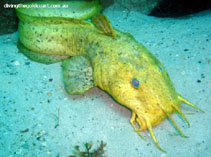| Family: |
Plotosidae (Eeltail catfishes) |
| Max. size: |
91 cm SL (male/unsexed); max.weight: 2,500.0 g; max. reported age: 13 years |
| Environment: |
demersal; brackish; marine; depth range 1 - 30 m |
| Distribution: |
Indo-Pacific: endemic to Australia. Present along both eastern and western Australian coasts, from Kirra in southern Queensland to Jervis Bay in New South Wales, and from Kingston in South Australia to the Houtman Abrolhos in Western Australia. Distributional range extension to the Duck River in Tasmania (Ref. 7300) needs verification. |
| Diagnosis: |
Dorsal spines (total): 1-1; Dorsal soft rays (total): 105-134; Anal spines: 0-0; Anal soft rays: 95-112; Vertebrae: 77-78 |
| Biology: |
An inshore marine species which lives in shallow bays and sandy inlets near river mouths (Ref. 2156). Found most frequently over sand, rocks and weeds in clear to turbid waters. By day, cobblers are most often found in holes and on ledges in banks (Ref. 6390). They are opportunistic feeders, primarily feeding at night. Food consists of bivalve and univalve mollusks, crustaceans (small prawns and amphipods), polychaete worms, algae and organic debris (Ref. 26551). Juveniles eat more crustaceans, often from among drifting macrophytic algae (Ref. 26548). Adults feed mainly on mollusks and polychaetes (Ref. 6390). They are prey to birds such as cormorants and pelicans (Ref. 26548). Presence of sharp spines on the dorsal and pectoral fins can inflict painful wounds (Ref. 2156). |
| IUCN Red List Status: |
Data deficient (DD); Date assessed: 04 February 2009 Ref. (130435)
|
| Threat to humans: |
venomous |
Source and more info: www.fishbase.org. For personal, classroom, and other internal use only. Not for publication.
